unit4where's my schoolbag 2b阅读公开课
- 格式:ppt
- 大小:2.81 MB
- 文档页数:18
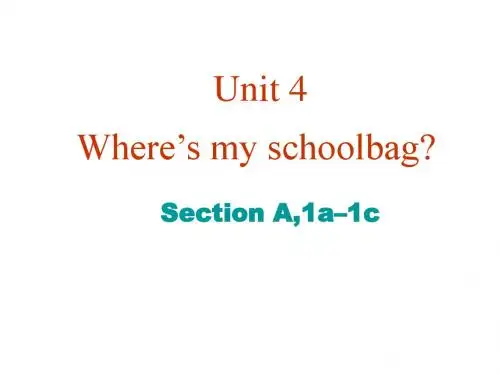
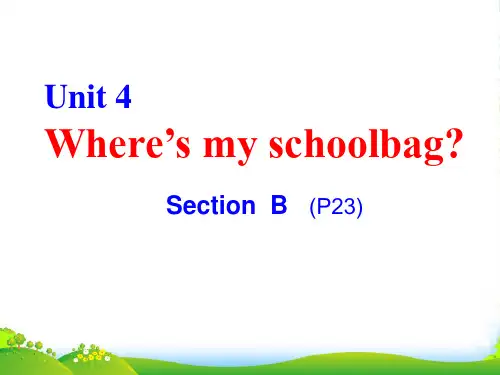
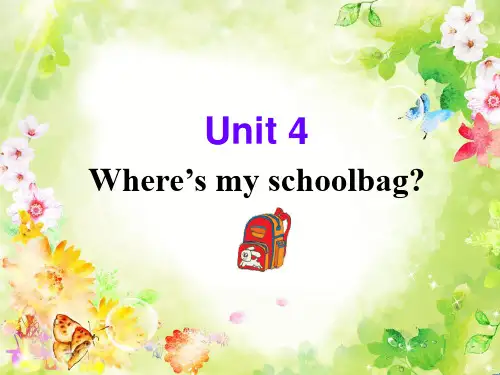
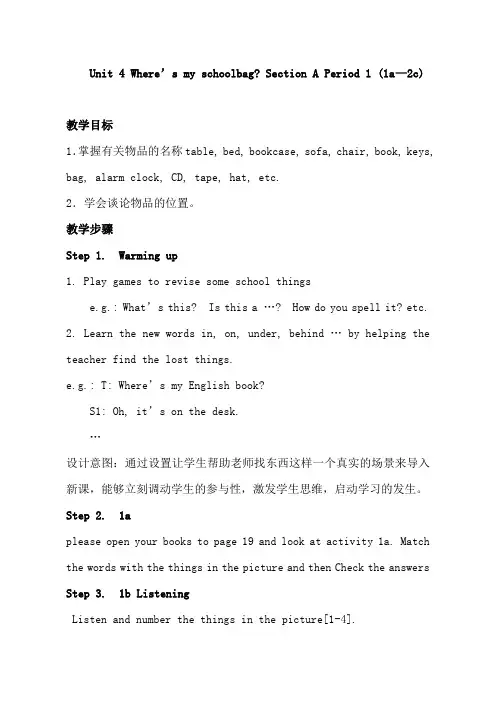
Unit 4 Where’s my schoolbag? Section A Period 1 (1a—2c)教学目标1.掌握有关物品的名称table, bed, bookcase, sofa, chair, book, keys, bag, alarm clock, CD, tape, hat, etc.2.学会谈论物品的位置。
教学步骤Step 1. Warming up1. Play games to revise some school thingse.g.: What’s this? Is this a …? How do you spell it? etc.2. Learn the new words in, on, under, behind … by helping the teacher find the lost things.e.g.: T: Where’s my English book?S1: Oh, it’s on the desk.…设计意图:通过设置让学生帮助老师找东西这样一个真实的场景来导入新课,能够立刻调动学生的参与性,激发学生思维,启动学习的发生。
Step 2. 1aplease open your books to page 19 and look at activity 1a. Match the words with the things in the picture and then Check the answers Step 3. 1b ListeningListen and number the things in the picture[1-4].Listen again and fill in the blanks.Listen again and Check the answers设计意图:由于课前引导学生通过自主学习初步接触本课要学的新单词,所以在新单词的教学过程中,一些有能力的学生可以将自己已有的认识水平与实际运用结合起来,使他们能体会到通过自主学习带来成功的满足感。
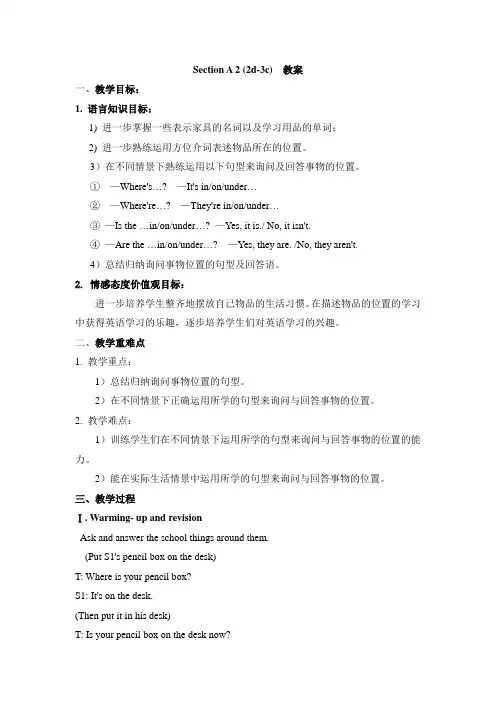
Section A 2 (2d-3c) 教案一、教学目标:1. 语言知识目标:1) 进一步掌握一些表示家具的名词以及学习用品的单词;2) 进一步熟练运用方位介词表述物品所在的位置。
3)在不同情景下熟练运用以下句型来询问及回答事物的位置。
①—Where's…? —It's in/on/under…②—Where're…? —They're in/on/under…③—Is the …in/on/under…? —Yes, it is./ No, it isn't.④—Are the …in/on/under…? —Yes, they are. /No, they aren't.4)总结归纳询问事物位置的句型及回答语。
2. 情感态度价值观目标:进一步培养学生整齐地摆放自己物品的生活习惯。
在描述物品的位置的学习中获得英语学习的乐趣,逐步培养学生们对英语学习的兴趣。
二、教学重难点1. 教学重点:1)总结归纳询问事物位置的句型。
2)在不同情景下正确运用所学的句型来询问与回答事物的位置。
2. 教学难点:1)训练学生们在不同情景下运用所学的句型来询问与回答事物的位置的能力。
2)能在实际生活情景中运用所学的句型来询问与回答事物的位置。
三、教学过程Ⅰ. Warming- up and revisionAsk and answer the school things around them.(Put S1's pencil box on the desk)T: Where is your pencil box?S1: It's on the desk.(Then put it in his desk)T: Is your pencil box on the desk now?S1: No, it isn't. It's in the desk.(Put it under the desk)T: Is your pencil box in the desk?S1: No, it isn't. It's under the desk.Ⅱ.Role-play1. Jack is a forgetful boy. He always doesn't know where his things are. Let's help him find his things.Match the things with the right places below.(Let Ss look at the screen. There are some things and some places)bag on his headmap on the sofahat on the bed in his grandparents' room2. Ss read the conversation and match the things with the right places.3. Check the answers.4. Now practice the conversation with your partner. Then let some pairs act out the conversation.5. 评价:(让学生们对自己的表现及语言表达能力进行自我评价,在小组内评价,然后进行评出最优秀的小组。
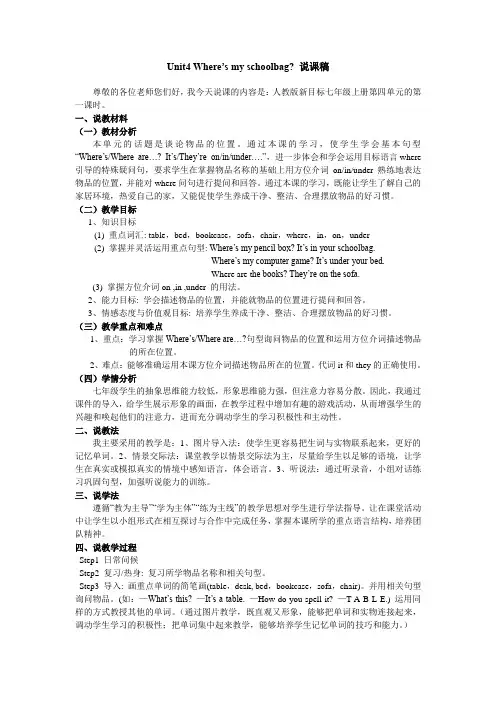
Unit4 Where’s my schoolbag? 说课稿尊敬的各位老师您们好,我今天说课的内容是:人教版新目标七年级上册第四单元的第一课时。
一、说教材料(一)教材分析本单元的话题是谈论物品的位置。
通过本课的学习,使学生学会基本句型“Where’s/Where are…? It’s/They’re on/in/under….”,进一步体会和学会运用目标语言where 引导的特殊疑问句,要求学生在掌握物品名称的基础上用方位介词on/in/under熟练地表达物品的位置,并能对where问句进行提问和回答。
通过本课的学习,既能让学生了解自己的家居环境,热爱自己的家,又能促使学生养成干净、整洁、合理摆放物品的好习惯。
(二)教学目标1、知识目标(1) 重点词汇: table,bed,bookcase,sofa,chair,where,in,on,under(2) 掌握并灵活运用重点句型: Where’s my pencil box? It’s in your schoolbag.Where’s my computer game? It’s under your bed.Where are t he books? They’re on the sofa.(3) 掌握方位介词on ,in ,under 的用法。
2、能力目标: 学会描述物品的位置,并能就物品的位置进行提问和回答。
3、情感态度与价值观目标: 培养学生养成干净、整洁、合理摆放物品的好习惯。
(三)教学重点和难点1、重点:学习掌握Where’s/Where are…?句型询问物品的位置和运用方位介词描述物品的所在位置。
2、难点:能够准确运用本课方位介词描述物品所在的位置。
代词it和they的正确使用。
(四)学情分析七年级学生的抽象思维能力较低,形象思维能力强,但注意力容易分散。
因此,我通过课件的导入,给学生展示形象的画面,在教学过程中增加有趣的游戏活动,从而增强学生的兴趣和唤起他们的注意力,进而充分调动学生的学习积极性和主动性。
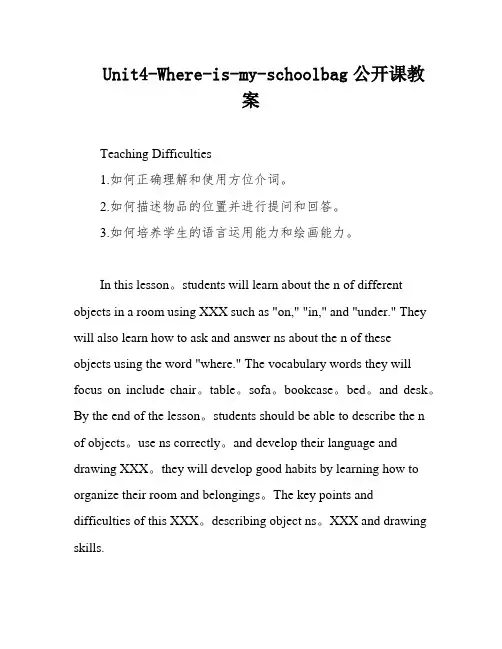
Unit4-Where-is-my-schoolbag公开课教案Teaching Difficulties1.如何正确理解和使用方位介词。
2.如何描述物品的位置并进行提问和回答。
3.如何培养学生的语言运用能力和绘画能力。
In this lesson。
students will learn about the n of different objects in a room using XXX such as "on," "in," and "under." They will also learn how to ask and answer ns about the n of these objects using the word "where." The vocabulary words they will focus on include chair。
table。
sofa。
bookcase。
bed。
and desk。
By the end of the lesson。
students should be able to describe the n of objects。
use ns correctly。
and develop their language and drawing XXX。
they will develop good habits by learning how to organize their room and belongings。
The key points and difficulties of this XXX。
describing object ns。
XXX and drawing skills.under with the help of pictures and a video。
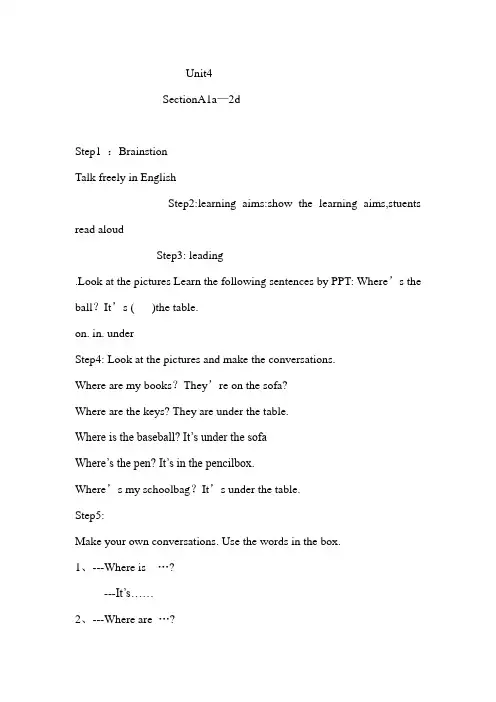
Unit4SectionA1a—2dStep1 :BrainstionTalk freely in EnglishStep2:learning aims:show the learning aims,stuents read aloudStep3: leading.Look at the pictures Learn the following sentences by PPT: Where’s the ball?It’s ( )the table.on. in. underStep4: Look at the pictures and make the conversations.Where are my books?They’re on the sofa?Where are the keys? They are under the table.Where is the baseball? It’s under the sofaWhere’s the pen? It’s in the pencilbox.Where’s my schoolbag?It’s under the table.Step5:Make your own conversations. Use the words in the box.1、---Where is …?---It’s……2、---Where are …?---They’re……on in underStep5:1a Match the words with the things in the picture.1.table____2.bed ___3.bookcase ____4.sofa____5.chair___6.schoolbag____7.books _____8.keys _____9.baseball_____10.plant ______Step7;1b 1.Listen and number the things [1-4] in the picture when you hear them.First let the Ss listen carefully.. Then check the answers2.观察与思考:询问单数物品时,用其答语用询问复数物品时用其答语用在上面的对话中,所使用的介词短语为这些介词短语都放于之后,用来表述物品所在的位置。
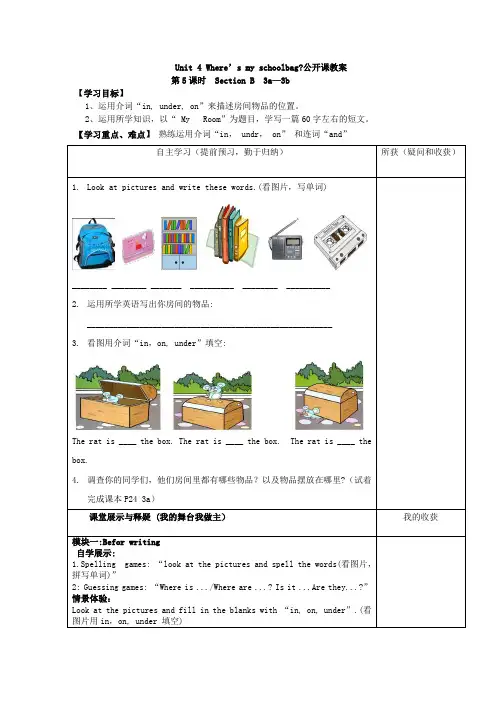
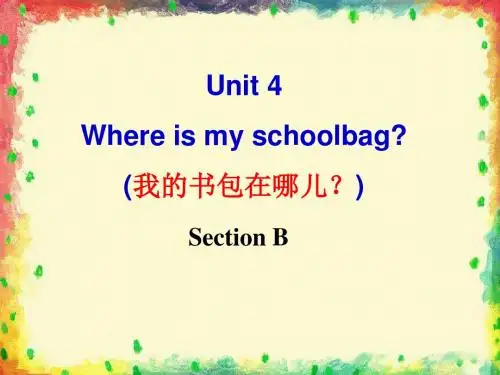

Period 2 Section A 2d-3cⅠ.教学准备1.教师:录音机、磁带、多媒体课件。
2.学生:复习学过的学习用品的名词,携带自己房间的图片或者画出自己房间的摆设。
Ⅱ.教学目标1.调动学生开口讲英语的积极性,激发学生学习英语的兴趣。
2.教给学生练习英语听力的方法和技巧。
3.学习本课的知识点:(1)词汇:come,come on,desk,think,room,their,hat,head,yeah,know(2)句型:—Are the keys on the sofa?—No,they aren't. They're on the table.—Where's his pencil box?—It's in his schoolbag.—Where's your ruler?—It's under the chair.—Where are their keys?—They're on the table.4.培养学生通过看图(如展示物体的位置)或看实物的位置,以口头形式进行情景表达的能力。
Ⅲ.教学重点(1)词汇:come,come on,desk,think,room,their,hat,head,yeah,know(2)句型:—Are the keys on the sofa?—No,they aren't. They're on the table.—Where's his pencil box?—It's in his schoolbag.—Where's your ruler?—It's under the chair.—Where are their keys?—They're on the table.Ⅳ.教学难点1.正确运用所学的介词描述物品的位置。
2.看图(如展示物体的位置)并熟练进行口头情景表达。
Unit 4 Where’s my schoolbag?【本章分析】本单元是《新目标英语》系列教材之一Go for it 第四单元的内容。
话题取材于《义务教育英语课程标准》话题项目表第三项(居住环境)中的第十一条。
该话题在初中教材中涉及广泛,因与学生日常生活紧密联系,学生有话可说,学习兴趣浓厚。
本单元以谈论物品的位置为话题;以紧扣话题的对话和一个小语篇为载体,在具体语境中呈现了where引导的特殊疑问句及答语,询问物品方位。
本单元学习的重点包括掌握家具名称,方位介词,及如何询问物品位置的核心句型,语法学习中强调形容词性人称代词(my, your, his, her etc.) 方位介词(in,on,under)以及be动词主谓一致。
本单元难点包括正确区分方位介词意义及be动词主谓一致。
本单元教学主要采用任务型语言教学(Task-Based Language Teaching)模式,完成任务的同时完成语言学习。
本单元建议安排5个课时。
第一课时Section A 1a-2c【本课分析】本课是一节听说课。
首先通过图文将学生带入“谈论物品名称及位置”的情境中,并在语境中输入“询问物品位置”的核心句型和重点词汇如:Where’s the schoolbag? It’s under the table. Where are mybooks? They’re on the sofa.并在此基础上以听力的形式拓展巩固单元重点句型,包括询问和回答物品位置和含be动词的一般疑问句。
本课是本单元的第一课时,在整个单元中起着话题导入的作用。
内容贴近学生生活,所含功能句都是日常用语,因此课堂任务应侧重培养学生的语言实践能力。
【学情分析】初一学生大部分刚开始系统学习英语,表现欲望强烈,敢于大胆开口,参与的积极性高这是学习英语的优势。
但是语言基础薄弱,会写字母和简单的单词但是语言的拓展运用能力较差,且学习过程中耐性不足。
教师在课堂设计时应发挥其优势,设计有趣的课堂任务引导学生进行自主学习和语言实践,渗透学法指导并引导学生逐步养成良好的学习习惯。